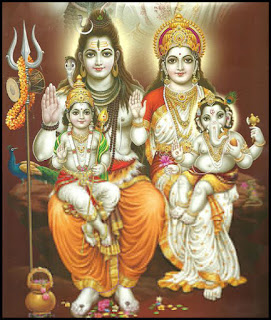Benares is replete with Shiva linga. The lingam of Shiva is everywhere in the city of Shiva. Pilgrims come in their thousands from throughout India to make pooja (prayers and offerings) at one or more of the lingam shrines, most notably at the Golden Temple, which is one of the twelve great lingams on the pilgrim circuit for devout Hindoos.
The extraordinary thing about the Shiva lingam is that, while the symbol is essentially and quite obviously a stylized phallus (usually united with a yoni, the stylized female part), this fact is not at all obvious to the average Shaivite devotee. In fact, most Hindoos are taken aback and scandalized by the realisation that Europeans (and other non-Hindoos) see the lingam as a phallus and therefore see devotions to the lingam as a form of phallic worship.
The fact that the lingam is phallic shaped does not even occur to the Hindoo, or if it does it does so via many filters of meaning and symbolism that remove it from any crudely sexual content. It is a remarkable phenomenon. Hindoo women may devote themselves to massaging the lingam of Shiva with lashings of cream and ghee, but it is only to outsiders that this seems like a blatently erotic act. The Hindoos theselves do not see it. Instead, for them, the symbol is encoded in a rich bed of mythology that mutes its phallic significance. For the Hindoo it is much more the 'pillar of light' of Shaivite cosmogony than an erect phallus (being gripped by a yoni.) The difference in what the tourist (outsider) sees in the temples of Benares and what the pilgrim Hindoo (participant) sees is truly striking. The Hindoo is genuinely offended if you remark upon the erotic nature of the lingam and yoni as symbols. He sees it, but he doesn't. And he resents having it pointed out.
Even the ithyphallic iconography of Lord Shiva is filtered from its blatent meaning in the Hindoo mind. Shiva will be shown fully erect, with his erect phallus absolutely upright. The outsider sees the erect phallus as a signal to sexual action. He concludes that sexual potency is an attribute of Shiva. For the Hindoo, however, the ithyphallic Shiva signifies exactly the opposite to a liscentious deity. In the Hindoo view this iconography symbolizes Lord Shiva's complete yogic control over his sexual appetites. The phallus is erect, but intact, and his seed unspilled. It may seem paradoxical to the non-Hindoo, but here the Hindoo sees an erect phallus as a symbol of sexual continence and self-control.
* * *
The iconography of Lord Shiva is far more extensive. While there is an abundance of aniconic linga throughout Benares, other presentations of Shiva's iconography are less common. The most vivid representations to be found are in the souvenir stores that dot the crowded laneways near the Golden Temple. There, pilgrims stock up on objects of Shaivite devotionalism or "All your pooja supplies!" as the storefronts promise. These feature large full-colour wall posters of the god in all his glory, often surrounded by his family. Shiva kitsch - much loved by the Hindoo. Below are some of the posters available. Notes on the icongraphy will follow.
Shiva and the Holy Family.
The closed eye in the centre of Lord Shiva's forehead. Shiva as destroyer. When this eye opens, the cosmos will be destroyed. Shiva as consciousness - when the universe is destroyed, the destroyer still remains. Shiva is the consciousness that remains after the whole of creation has ended.
The cobra around Lord Shiva's neck. The cobra is tame. Shiva has conquered his appetites and passions. He wears his passions as a necklace.
The twin drum. Duality.
Shiva is typically shown dressed as a mendicant and seated meditating. In one hand, the prayer beads. Perpetual mantra.
The crescent moon. Shiva as god of time.
The three lines of ash on the forehead - the three worlds (through which the axis of light extends).
Yours,
Harper McAlpine Black
















Interesting article on how perception shapes reality particularly as it relates to different cultures.
ReplyDelete